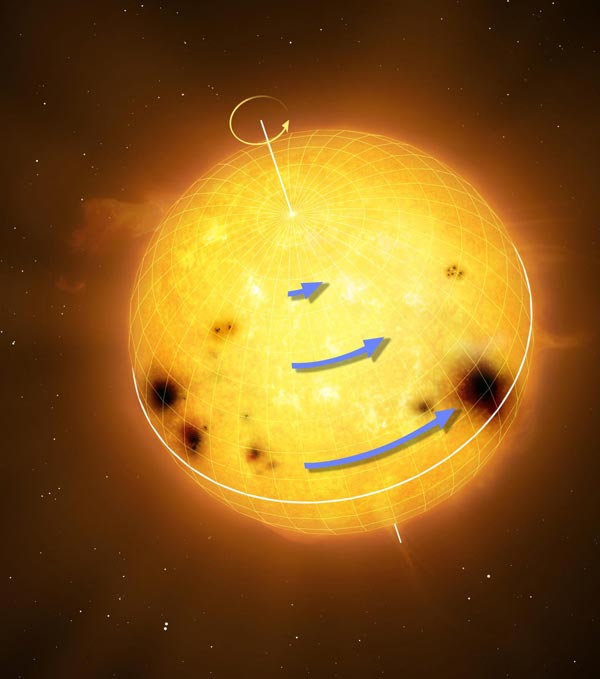Astrophysicists measure precise rotation pattern of sun-like stars for the first time

Sun-like stars rotate differentially, with the equator rotating faster than the higher latitudes. The blue arrows in the figure represent rotation speed. Differential rotation is thought to be an essential ingredient for generating magnetic activity and starspots. Credit: MPI for Solar System Research/MarkGarlick.com
Sun-like stars rotate up to two and a half times faster at the equator than at higher latitudes, a finding by researchers at NYU Abu Dhabi that challenges current science on how stars rotate.
Until now, little was known about the precise rotational patterns of Sun-like stars, only that the equator spins faster than at higher latitudes, similar to the Sun.
Scientists at the NYU Abu Dhabi Center for Space Science used observations from NASA's Kepler mission and asteroseismology — the study of sound waves traveling inside stars — to determine with precision how Sun-like stars rotate, which no other scientific method has been able to achieve.
Their study found that Sun-like stars, characterized as being like the Sun in mass and age, do indeed rotate in a similar manner as the Sun in that their equatorial regions rotate more rapidly than at mid- to high latitudes. But there's a key difference.
The equator of the Sun rotates about 10 percent faster than its mid latitudes, while equators of Sun-like stars spin up to two and a half times faster than their mid latitudes.
“This is very unexpected, and challenges current numerical simulations, which suggest that stars like these should not be able to sustain differential rotation of this magnitude,” said Othman Benomar, research associate at the NYU Abu Dhabi Center for Space Science and lead author of the study published in Science.
“Understanding differential rotation — how fast one part of a star spins compared to the rest — is not only important for a complete understanding of how a star works, it will help us gain deeper insights about their magnetic fields,” explained Katepalli Sreenivasan, principal investigator of the NYU Abu Dhabi Center for Space Science.
Magnetic fields on the Sun have been known to cause enormous solar storms that frequently disrupt orbiting space satellites and have knocked out power grids on Earth.
Scientists agree that the rotation of the Sun plays a crucial role in the generation of the solar magnetic field, but the exact details still remain a mystery, despite the Sun having been observed and studied in great detail.
Sreenivasan added, “learning more about how stars rotate and generate their own magnetic fields could help us gain further insight into the solar dynamo, the physical process that generates the Sun's magnetic field.”
###
The NYUAD Center for Space Science is supported by the NYUAD Research Institute, which promotes cutting-edge and innovative research through the support of its 12 centers, labs, and projects.
Additional facts
Asteroseismology
Allows scientists to determine precisely how a star rotates by measuring frequencies of acoustic waves inside the star. Helioseismology is used on the Sun for the same purpose.
Differential rotation
Rotation speeds on the Sun and stars vary at different latitudes because they are fluid (the middle spins faster than the poles). By contrast, a spinning basketball has rigid rotation — it spins at the same speed from top to bottom.
About NYU Abu Dhabi
NYU Abu Dhabi is the first comprehensive liberal arts and science campus in the Middle East to be operated abroad by a major American research university. NYU Abu Dhabi has integrated a highly-selective liberal arts, engineering and science curriculum with a world center for advanced research and scholarship enabling its students to succeed in an increasingly interdependent world and advance cooperation and progress on humanity's shared challenges. NYU Abu Dhabi's high-achieving students have come from 115 nations and speak over 115 languages. Together, NYU's campuses in New York, Abu Dhabi, and Shanghai form the backbone of a unique global university, giving faculty and students opportunities to experience varied learning environments and immersion in other cultures at one or more of the numerous study-abroad sites NYU maintains on six continents.
Media Contact
Adam Pockriss
apockriss@rubenstein.com
212-843-8286
NYU Abu Dhabi – Google-Suche
Media Contact
More Information:
https://nyuad.nyu.edu/All latest news from the category: Physics and Astronomy
This area deals with the fundamental laws and building blocks of nature and how they interact, the properties and the behavior of matter, and research into space and time and their structures.
innovations-report provides in-depth reports and articles on subjects such as astrophysics, laser technologies, nuclear, quantum, particle and solid-state physics, nanotechnologies, planetary research and findings (Mars, Venus) and developments related to the Hubble Telescope.
Newest articles

Properties of new materials for microchips
… can now be measured well. Reseachers of Delft University of Technology demonstrated measuring performance properties of ultrathin silicon membranes. Making ever smaller and more powerful chips requires new ultrathin…

Floating solar’s potential
… to support sustainable development by addressing climate, water, and energy goals holistically. A new study published this week in Nature Energy raises the potential for floating solar photovoltaics (FPV)…

Skyrmions move at record speeds
… a step towards the computing of the future. An international research team led by scientists from the CNRS1 has discovered that the magnetic nanobubbles2 known as skyrmions can be…





















